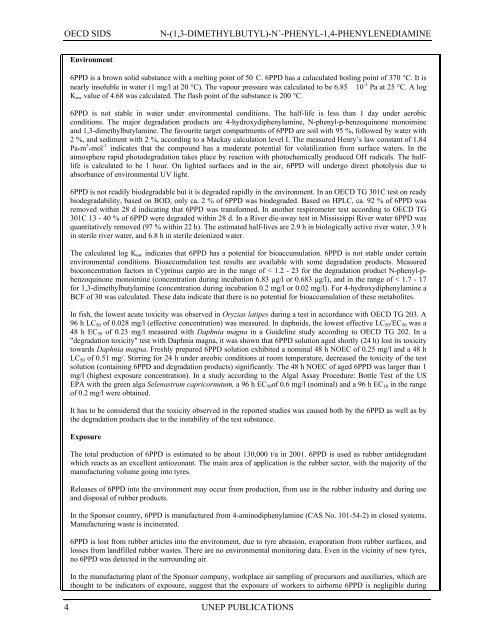N-(1,3-Dimethylbutyl)-N
N-(1,3-Dimethylbutyl)-N
N-(1,3-Dimethylbutyl)-N
Create successful ePaper yourself
Turn your PDF publications into a flip-book with our unique Google optimized e-Paper software.
OECD SIDS<br />
N-(1,3-DIMETHYLBUTYL)-N´-PHENYL-1,4-PHENYLENEDIAMINE<br />
Environment<br />
6PPD is a brown solid substance with a melting point of 50C. 6PPD has a caluculated boiling point of 370 °C. It is<br />
nearly insoluble in water (1 mg/l at 20 °C). The vapour pressure was calculated to be 6.85 10 -3 Pa at 25 °C. A log<br />
K ow value of 4.68 was calculated. The flash point of the substance is 200 °C.<br />
6PPD is not stable in water under environmental conditions. The half-life is less than 1 day under aerobic<br />
conditions. The major degradation products are 4-hydroxydiphenylamine, N-phenyl-p-benzoquinone monoimine<br />
and 1,3-dimethylbutylamine. The favourite target compartments of 6PPD are soil with 95 %, followed by water with<br />
2 %, and sediment with 2 %, according to a Mackay calculation level I. The measured Henry’s law constant of 1.84<br />
Pa * m 3 *mol -1 indicates that the compound has a moderate potential for volatilization from surface waters. In the<br />
atmosphere rapid photodegradation takes place by reaction with photochemically produced OH radicals. The halflife<br />
is calculated to be 1 hour. On lighted surfaces and in the air, 6PPD will undergo direct photolysis due to<br />
absorbance of environmental UV light.<br />
6PPD is not readily biodegradable but it is degraded rapidly in the environment. In an OECD TG 301C test on ready<br />
biodegradability, based on BOD, only ca. 2 % of 6PPD was biodegraded. Based on HPLC, ca. 92 % of 6PPD was<br />
removed within 28 d indicating that 6PPD was transformed. In another respirometer test according to OECD TG<br />
301C 13 - 40 % of 6PPD were degraded within 28 d. In a River die-away test in Mississippi River water 6PPD was<br />
quantitatively removed (97 % within 22 h). The estimated half-lives are 2.9 h in biologically active river water, 3.9 h<br />
in sterile river water, and 6.8 h in sterile deionized water.<br />
The calculated log K ow indicates that 6PPD has a potential for bioaccumulation. 6PPD is not stable under certain<br />
environmental conditions. Bioaccumulation test results are available with some degradation products. Measured<br />
bioconcentration factors in Cyprinus carpio are in the range of < 1.2 - 23 for the degradation product N-phenyl-pbenzoquinone<br />
monoimine (concentration during incubation 6.83 µg/l or 0.683 µg/l), and in the range of < 1.7 - 17<br />
for 1,3-dimethylbutylamine (concentration during incubation 0.2 mg/l or 0.02 mg/l). For 4-hydroxydiphenylamine a<br />
BCF of 30 was calculated. These data indicate that there is no potential for bioaccumulation of these metabolites.<br />
In fish, the lowest acute toxicity was observed in Oryzias latipes during a test in accordance with OECD TG 203. A<br />
96 h LC 50 of 0.028 mg/l (effective concentration) was measured. In daphnids, the lowest effective LC 50 /EC 50 was a<br />
48 h EC 50 of 0.23 mg/l measured with Daphnia magna in a Guideline study according to OECD TG 202. In a<br />
"degradation toxicity" test with Daphnia magna, it was shown that 6PPD solution aged shortly (24 h) lost its toxicity<br />
towards Daphnia magna. Freshly prepared 6PPD solution exhibited a nominal 48 h NOEC of 0.25 mg/l and a 48 h<br />
LC 50 of 0.51 mg/. Stirring for 24 h under areobic conditions at room temperature, decreased the toxicity of the test<br />
solution (containing 6PPD and degradation products) significantly. The 48 h NOEC of aged 6PPD was larger than 1<br />
mg/l (highest exposure concentration). In a study according to the Algal Assay Procedure: Bottle Test of the US<br />
EPA with the green alga Selenastrum capricornutum, a 96 h EC 50 of 0.6 mg/l (nominal) and a 96 h EC 10 in the range<br />
of 0.2 mg/l were obtained.<br />
It has to be considered that the toxicity observed in the reported studies was caused both by the 6PPD as well as by<br />
the degradation products due to the instability of the test substance.<br />
Exposure<br />
The total production of 6PPD is estimated to be about 130,000 t/a in 2001. 6PPD is used as rubber antidegradant<br />
which reacts as an excellent antiozonant. The main area of application is the rubber sector, with the majority of the<br />
manufacturing volume going into tyres.<br />
Releases of 6PPD into the environment may occur from production, from use in the rubber industry and during use<br />
and disposal of rubber products.<br />
In the Sponsor country, 6PPD is manufactured from 4-aminodiphenylamine (CAS No. 101-54-2) in closed systems.<br />
Manufacturing waste is incinerated.<br />
6PPD is lost from rubber articles into the environment, due to tyre abrasion, evaporation from rubber surfaces, and<br />
losses from landfilled rubber wastes. There are no environmental monitoring data. Even in the vicinity of new tyres,<br />
no 6PPD was detected in the surrounding air.<br />
In the manufacturing plant of the Sponsor company, workplace air sampling of precursors and auxiliaries, which are<br />
thought to be indicators of exposure, suggest that the exposure of workers to airborne 6PPD is negligible during<br />
4<br />
UNEP PUBLICATIONS
















